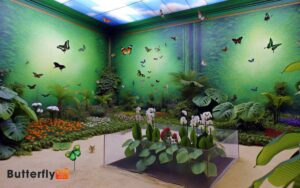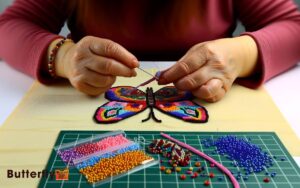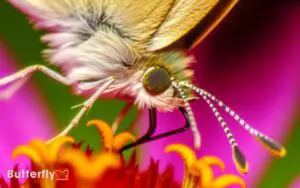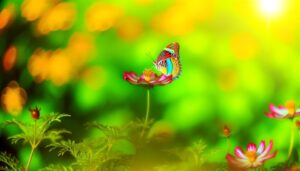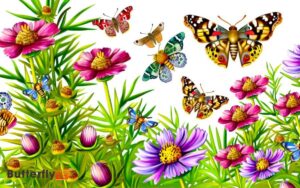How to Spot Butterflies During Each Season
Butterflies' seasonal presence hinges on regional climatic nuances and their distinct lifecycles, which consist of egg, larva, pupa, and adult stages. In temperate zones, butterflies are most abundant from late spring to early summer, aligning with the phenology of host plants.
Tropical regions, benefiting from stable temperatures, see butterflies year-round, peaking during wet seasons. Alpine and arid regions offer brief windows of butterfly activity when conditions are favorable.
Notable migratory species like Monarchs exhibit complex, season-dependent patterns. By exploring further, you'll gain insights into how regional climates and butterfly adaptations interplay.
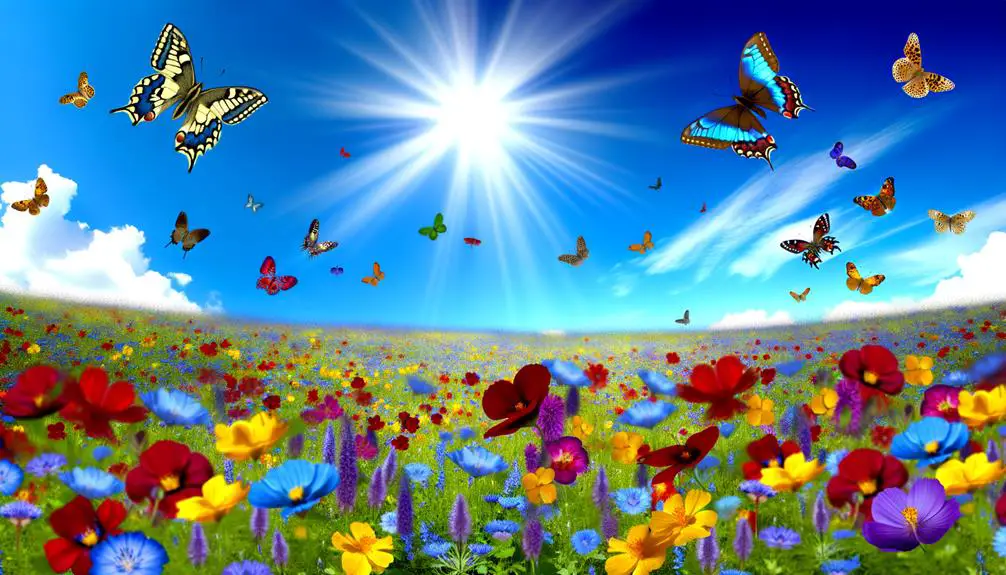
Key Takeaways
- In temperate zones, butterflies are most active from late spring to early summer.
- Tropical regions see butterfly activity year-round, peaking during wet seasons.
- Alpine and arid regions have brief butterfly emergence windows during favorable conditions.
- Migratory species like Monarchs show complex seasonal patterns, often migrating in fall.
Understanding Butterfly Lifecycles

Understanding butterfly lifecycles requires a thorough examination of their four distinct developmental stages: egg, larva (caterpillar), pupa (chrysalis), and adult butterfly. Each stage is characterized by unique biological processes and morphological changes.
The egg stage, typically lasting a few days, marks the beginning of development. Upon hatching, the larva emerges, engaging in intense feeding and rapid growth, often undergoing multiple molts.
The subsequent pupa stage involves remarkable metamorphosis within the chrysalis, where larval structures are reorganized into adult features. Finally, the adult butterfly emerges, equipped for reproduction and dispersal.
This intricate lifecycle, governed by genetic and environmental factors, underscores the complexity of Lepidopteran development and adaptation, providing insight into their ecological roles and evolutionary success.
Regional Butterfly Seasons
Regional butterfly seasons vary considerably across different geographic areas, influenced by local climate conditions, vegetation types, and ecological interactions.
In temperate zones, butterfly activity typically peaks during late spring to early summer, aligning with ideal temperatures and abundant floral resources. During this period, butterflies emerge in large numbers, taking advantage of blooming plants for nectar and reproduction. Similarly, the best months for butterflies in Florida extend beyond temperate zones, often spanning from early spring through late fall due to the state’s warm climate. This extended season allows for a greater diversity of butterfly species to thrive and remain active for a longer duration.
Conversely, in tropical regions, butterfly populations can remain active year-round, although peak abundance often coincides with wet seasons that promote lush vegetation.
Alpine and arid regions present unique challenges; butterflies in these areas may emerge during brief windows when environmental conditions are favorable.
Additionally, migratory species, such as the Monarch butterfly, exhibit complex seasonal patterns, traveling thousands of kilometers to exploit different regional climates.
Consequently, understanding regional butterfly seasons necessitates thorough knowledge of local ecological dynamics and climatic influences.
Spring Butterflies
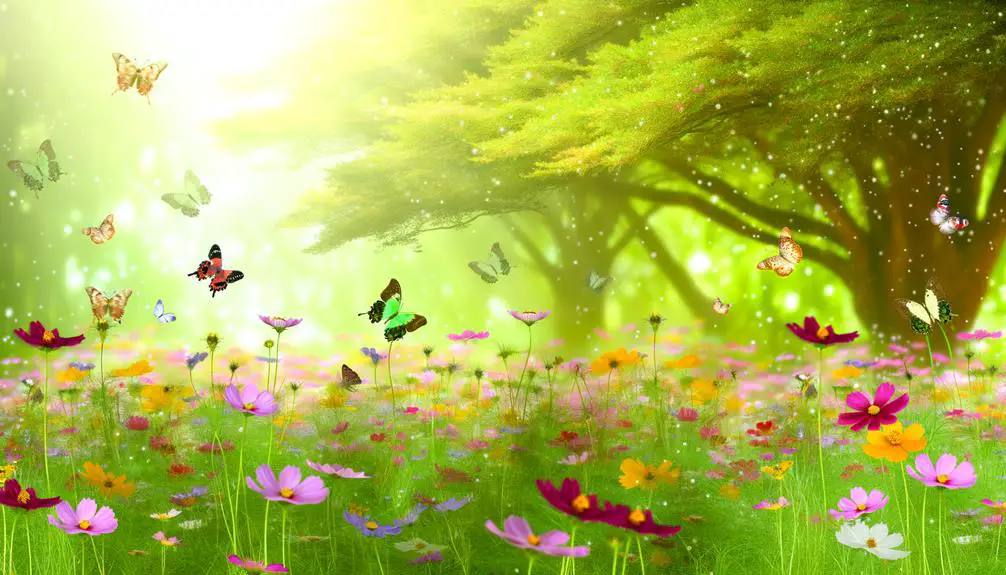
Spring butterflies represent a diverse array of species that emerge with the onset of warmer temperatures and increased daylight, capitalizing on the seasonal proliferation of nectar-rich flowers and new plant growth for larval development.
Key species such as the Mourning Cloak (Nymphalis antiopa) and Eastern Tiger Swallowtail (Papilio glaucus) are often among the first to appear.
These butterflies exhibit synchronized emergence aligned with the phenology of host plants, ensuring ideal conditions for egg-laying and larval nourishment.
The interaction between these lepidopterans and their environment is a finely tuned ecological relationship, with butterflies serving as essential pollinators while their caterpillars contribute to plant dynamics through herbivory.
Understanding these patterns enhances our appreciation of spring's ecological tapestry.
Summer Butterflies
As summer progresses, butterfly populations reach their peak diversity and abundance, with many species exhibiting distinct adaptations to the extended daylight and higher temperatures. These environmental conditions foster accelerated metabolic rates and heightened activity patterns, facilitating efficient foraging and mating behaviors.
| Species | Notable Adaptations |
|---|---|
| Monarch (Danaus plexippus) | Migratory behavior, heat tolerance |
| Painted Lady (Vanessa cardui) | Wide range of host plants, rapid development |
| Swallowtail (Papilio machaon) | Thermal regulation, vibrant coloration |
| Red Admiral (Vanessa atalanta) | Territoriality, temperature-sensitive reproduction |
| Common Buckeye (Junonia coenia) | Seasonal form variation, sun basking |
Observational data indicate increased interactions among butterfly species and their respective ecosystems. Such interactions underscore the intricate balance between biotic and abiotic factors during the summer months.
Fall Butterflies
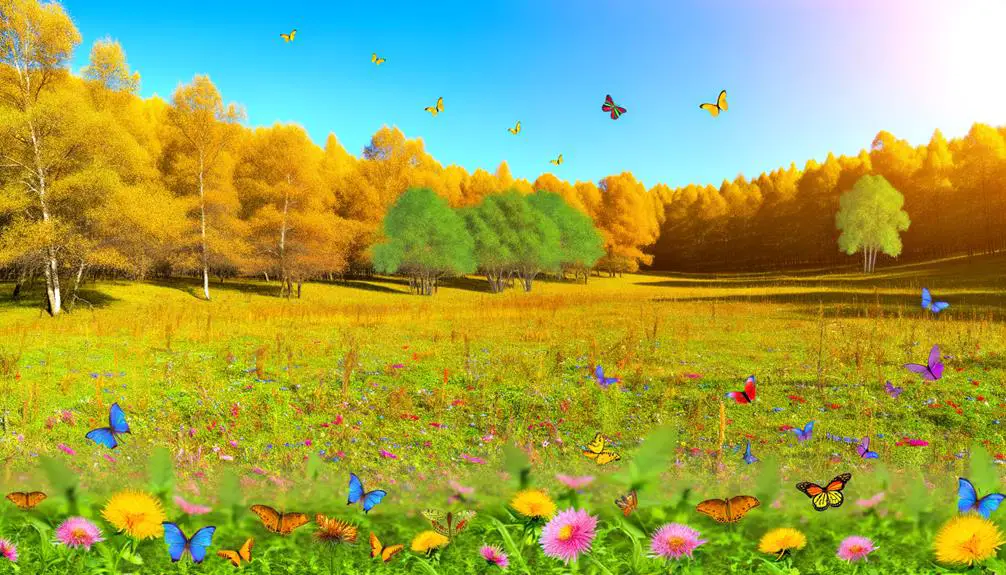
During the fall, butterfly populations undergo significant behavioral and physiological changes in response to decreasing temperatures and shorter daylight hours. Many species, such as the Monarch (Danaus plexippus), initiate long-distance migrations to warmer climates, a phenomenon driven by the need to find suitable overwintering habitats.
Physiologically, some butterflies enter a state known as diapause, a form of dormancy that halts development and conserves energy. Nectar sources become scarcer, prompting butterflies to shift their feeding habits, often favoring late-blooming flowers and overripe fruits.
Additionally, fall butterflies exhibit changes in coloration and wing robustness to better withstand cooler temperatures and increased predation risks. These adaptive strategies are essential for survival as environmental conditions become less favorable.
Winter Butterflies
Winter butterflies exhibit remarkable cold weather adaptations that enable their survival through harsh conditions.
Specific species, such as the Mourning Cloak (Nymphalis antiopa), employ physiological and behavioral strategies, including antifreeze-like chemicals and hibernation.
Understanding these survival mechanisms provides insight into the resilience and ecological niches of lepidopteran species during the winter months.
Cold Weather Adaptations
To survive the harsh conditions of winter, butterflies have evolved a variety of physiological and behavioral adaptations that allow them to endure cold temperatures.
Diapause, a state of suspended development, is one such adaptation, permitting butterflies to halt their lifecycle until favorable conditions return.
In addition, some species accumulate glycerol, a form of antifreeze, in their hemolymph to prevent ice formation within their cells.
Behavioral strategies include seeking microhabitats that offer thermal insulation, such as leaf litter, tree bark, or man-made structures.
Moreover, certain butterflies demonstrate migratory behavior, relocating to warmer climates to avoid lethal cold.
These adaptations collectively guarantee that butterflies can survive and subsequently reproduce when environmental conditions improve.
Winter Butterfly Species
Among the myriad of butterflies exhibiting remarkable adaptations for winter survival, several species are uniquely adapted to remain active even during the coldest months.
One notable example is the Mourning Cloak (Nymphalis antiopa), which can be observed flying on mild winter days. This species employs a physiological state known as diapause to endure freezing temperatures.
Another winter-active species is the Comma Butterfly (Polygonia c-album), characterized by its cryptic coloration that aids in camouflage against predators.
The Red Admiral (Vanessa atalanta), although typically migratory, can also be seen during winter in milder climates.
These butterflies demonstrate extraordinary resilience, showcasing specialized adaptations that permit their survival and occasional activity during the harsh conditions of winter.
Survival Strategies Employed
Several physiological and behavioral adaptations are pivotal for winter butterflies to withstand and navigate the challenges of cold climates.
Diapause, a state of suspended development, enables larvae, pupae, or adults to endure unfavorable conditions by considerably reducing metabolic activity. Glycoprotein antifreeze compounds prevent ice crystal formation within their cells, mitigating damage from sub-zero temperatures.
Behavioral strategies include seeking microhabitats such as tree bark crevices or leaf litter, which provide insulation and protection from wind exposure. Additionally, some species utilize basking behaviors to absorb solar radiation, thereby elevating their body temperature to functional levels.
These combined strategies are essential for survival during winter, ensuring that butterflies can resume their life cycles when favorable conditions return.
Butterfly Migration Patterns
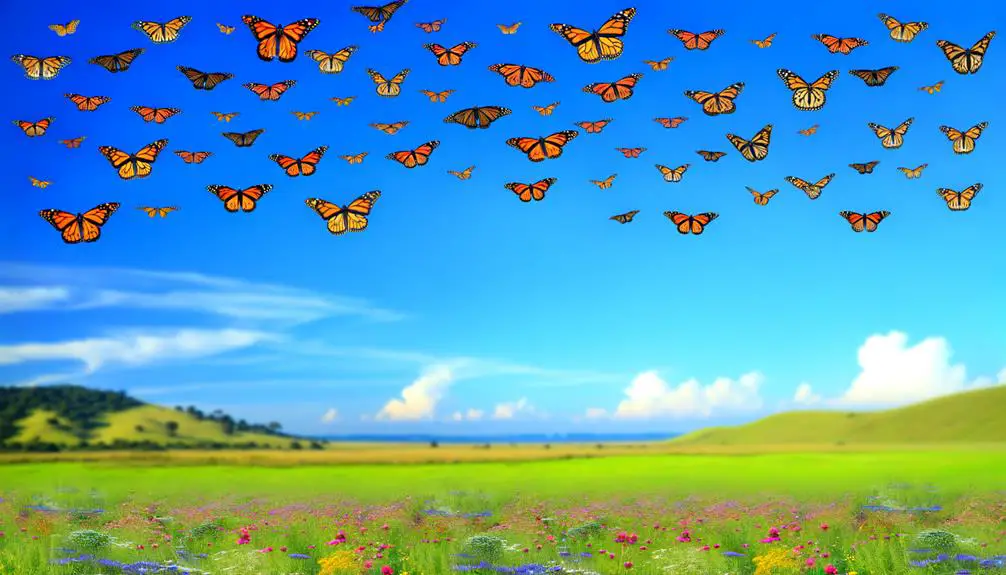
Butterfly migration patterns exhibit distinct seasonal routes influenced by both geographical and climatic factors. These routes are meticulously timed with climatic cues such as temperature variations and daylight length, ensuring ideal conditions for survival and reproduction.
Observations reveal that climate change considerably alters migration timing, potentially disrupting established patterns and impacting butterfly populations.
Seasonal Migration Routes
Each year, millions of butterflies initiate intricate migration journeys that span thousands of kilometers, driven by seasonal changes and environmental cues.
Among the most studied are the Monarch butterflies (Danaus plexippus), which travel from North America to central Mexico. This transcontinental voyage is facilitated by navigational mechanisms responding to the Earth's magnetic fields and solar positioning.
Painted Lady butterflies (Vanessa cardui) also exhibit extensive migratory behavior, flying from Europe to North Africa.
These migrations are not random but follow established routes, often taking advantage of thermal updrafts and favorable wind currents.
Precise timing guarantees synchronization with the availability of host plants for oviposition and nectar sources for sustenance, highlighting the ecological intricacies of butterfly seasonal migration routes.
Climate Influence Timing
Understanding the timing of these migratory patterns requires examining how climate factors, such as temperature fluctuations and precipitation changes, influence the physiological and behavioral responses of butterflies. Elevated temperatures can accelerate metabolic rates, prompting earlier departures, while cooler temperatures may delay migration.
Precipitation patterns also play a vital role; increased rainfall can enhance nectar availability, impacting migratory readiness. Conversely, drought conditions may force premature migration due to resource scarcity.
Additionally, climate-induced shifts in wind patterns can either facilitate or hinder migratory progress. These climatic influences collectively shape the phenology of butterfly migrations, dictating when populations commence on their journeys.
Detailed studies utilizing climatic models and long-term observations are essential to predict and understand these dynamic migration patterns accurately.
Attracting Butterflies
To attract butterflies effectively, it is vital to cultivate a diverse array of nectar-rich flowering plants that provide sustenance throughout their various life stages. These plants not only offer the necessary resources for adult butterflies but also serve as host plants for larvae.
Observations indicate that butterflies are drawn to bright colors, particularly reds, oranges, and purples, which are abundant in nectar-producing flora.
Additionally, incorporating water sources such as shallow puddles or damp sand can cater to their hydration needs.
Maintaining a pesticide-free environment is important, as chemicals can deter or harm butterflies and their larvae.
Strategic planting guarantees continuous blooming, thereby supporting butterfly populations during their active seasons.
Best Plants for Butterflies
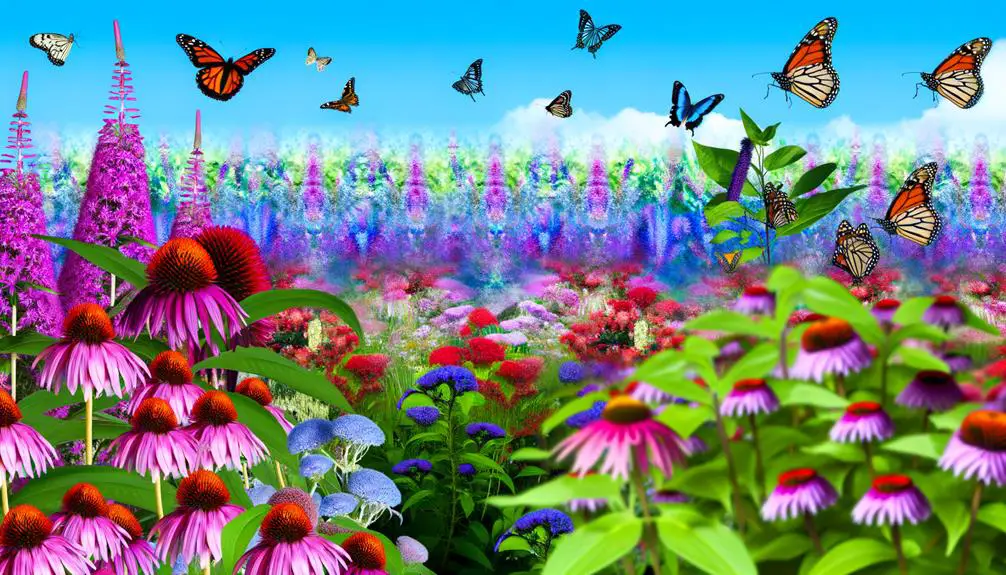
Selecting the most effective plants to attract and sustain butterflies involves identifying species known for their high nectar production and suitability as larval host plants.
Key nectar sources include Buddleja davidii (butterfly bush), Asclepias spp. (milkweed), and Lantana camara. These plants produce copious nectar, essential for adult butterfly sustenance.
Larval host plants are equally critical; for instance, Asclepias incarnata (swamp milkweed) is indispensable for Monarch caterpillars, while Passiflora incarnata (passionflower) serves as a host for Gulf Fritillaries.
Observations indicate that plant diversity enhances butterfly visitation, as different species cater to various butterfly preferences and life stages.
Strategic selection and placement of these plants can greatly elevate the ecological value of a garden for butterfly populations.
Creating a Butterfly Habitat
Establishing a thriving butterfly habitat necessitates the strategic selection of native plant species, which offer essential nectar sources and caterpillar host plants.
Additionally, integrating accessible water sources such as shallow dishes or damp sand patches can greatly enhance hydration opportunities for butterflies.
Choosing Native Plants
In creating a butterfly habitat, choosing native plants is paramount as these species coevolved with local butterfly populations, providing essential nectar sources and larval host plants.
Native flora, such as Asclepias spp. (milkweeds) for monarchs or Echinacea spp. (coneflowers) for various nymphalids, form the backbone of a sustainable butterfly garden.
These plants offer ideal nutritional profiles and bloom periods synchronized with butterfly life cycles. Additionally, native plants exhibit resilience to local climatic conditions and pest pressures, enhancing garden stability.
Observational studies have shown that butterflies exhibit higher visitation rates and reproductive success in gardens featuring native species.
Consequently, selecting indigenous vegetation not only supports butterfly biodiversity but also fosters ecological balance and conservational integrity within the habitat.
Providing Water Sources
Ensuring adequate water sources within a butterfly habitat is essential for maintaining hydration and facilitating critical behaviors such as feeding and mating.
Butterflies primarily acquire moisture and dissolved minerals through puddling, a behavior where they sip from damp soil, mud, or shallow water.
To create a suitable habitat, provide shallow dishes with sand and water, ensuring the water level remains just below the sand surface. Additionally, incorporating flat stones or gravel in these water sources allows butterflies to land and drink without submersion risk.
Regularly replenish water to prevent stagnation and mosquito breeding. Observing butterfly activity around these water sources can offer insights into their hydration needs and overall habitat health, thereby enhancing conservation efforts.
Ensuring Shelter Spots
Creating a butterfly habitat necessitates the inclusion of sheltered spots that provide protection from predators, extreme weather, and other environmental stresses. Ensuring these safe havens involves strategic planning and implementation.
Key elements include:
- Dense Vegetation: Planting shrubs and tall grasses offers natural cover, providing butterflies with places to hide and rest.
- Leaf Litter: A layer of decomposing leaves on the ground serves as a refuge for larvae and pupae, essential stages in the butterfly lifecycle.
- Rock Piles and Logs: These structures offer microhabitats that shield butterflies from wind and rain while allowing basking opportunities.
- Man-made Shelters: Installing butterfly houses or shelters can offer additional protection, especially in areas lacking natural cover.
Observing Butterflies Responsibly
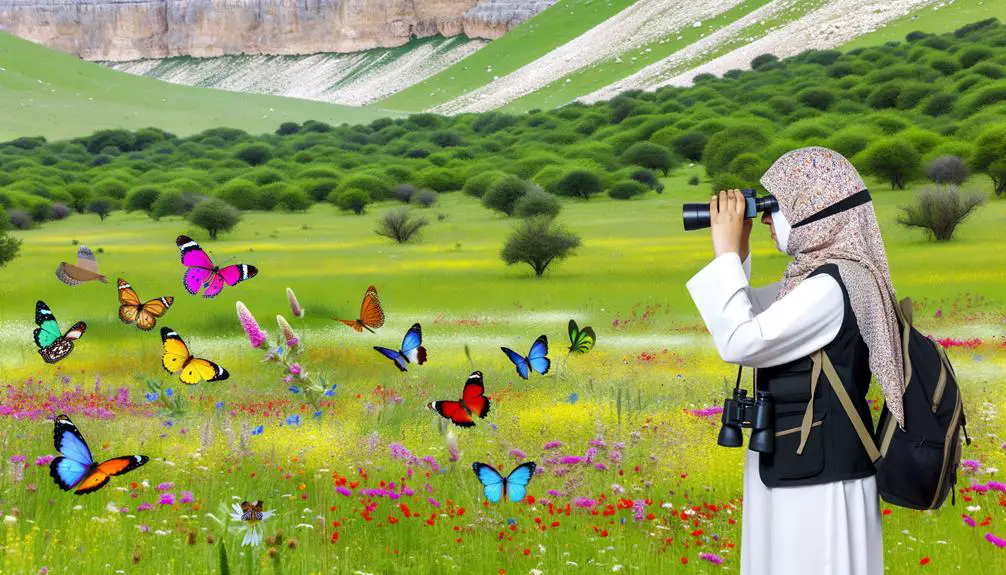
Observing butterflies requires a meticulous approach to avoid disrupting their natural behaviors and habitats. Enthusiasts must maintain a respectful distance, guaranteeing minimal physical disturbance and noise pollution.
Utilizing optical equipment such as binoculars allows for detailed observations without intruding on the butterflies' space. Researchers recommend visiting during early mornings when butterflies are most active and light conditions are ideal for viewing.
Avoid handling butterflies, as oils from human skin can damage their delicate wings. Recording observations in a non-intrusive manner, such as through photography or note-taking, supports scientific study without negatively impacting the population.
Conclusion
The seasonal presence of butterflies is intricately linked to their lifecycles and regional climatic conditions. Spring, summer, and fall each host distinct butterfly species, with each requiring specific floral resources and habitats.
To attract and sustain these lepidopterans, what better strategy exists than cultivating appropriate flora and creating conducive environments? Observational practices must prioritize ecological responsibility to guarantee the continued existence of these pollinators.
Hence, understanding and supporting butterfly habitats are essential for biodiversity conservation.

